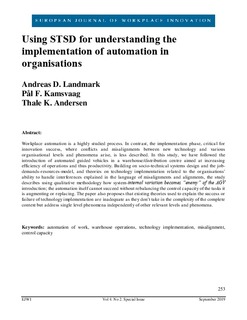| dc.contributor.author | Landmark, Andreas D. | |
| dc.contributor.author | Kamsvaag, Pål Furu | |
| dc.contributor.author | Andersen, Thale Kvernberg | |
| dc.date.accessioned | 2020-02-05T12:25:40Z | |
| dc.date.available | 2020-02-05T12:25:40Z | |
| dc.date.created | 2019-09-25T16:26:41Z | |
| dc.date.issued | 2019 | |
| dc.identifier.citation | European Journal of Workplace Innovation. 2019, 4 (2), 253-271. | nb_NO |
| dc.identifier.issn | 2387-4570 | |
| dc.identifier.uri | http://hdl.handle.net/11250/2639819 | |
| dc.description.abstract | Workplace automation is a highly studied process. In contrast, the implementation phase – critical for innovation success – where conflicts and misalignments between new technology and various organisational levels and phenomena arise, is less described. In this study, we have followed the introduction of automated guided vehicles in a warehouse/distribution centre aimed at increasing efficiency of operations and thus productivity.
Building on socio-technical systems design and the job-demands-resources-model, and theories on technology implementation related to the organisations' ability to handle interferences explained in the language of misalignments and alignments, the study describes using qualitative methodology how system-internal variation becomes “enemy” of the AGV introduction; the automation itself cannot succeed without rebalancing the control capacity of the tasks it is augmenting or replacing. The paper also proposes that existing theories used to explain the success or failure of technology implementation are inadequate as they don't take in the complexity of the complete context but address single level phenomena independently of other relevant levels and phenomena. | nb_NO |
| dc.language.iso | eng | nb_NO |
| dc.publisher | Department of Working Life and Innovation, University of Agder | nb_NO |
| dc.relation.uri | https://journal.uia.no/index.php/EJWI/article/view/579/447 | |
| dc.rights | Navngivelse 4.0 Internasjonal | * |
| dc.rights.uri | http://creativecommons.org/licenses/by/4.0/deed.no | * |
| dc.subject | Automation | nb_NO |
| dc.subject | STSD | nb_NO |
| dc.subject | Workplaces | nb_NO |
| dc.title | Using STSD for understanding the implementation of automation in organisations | nb_NO |
| dc.type | Journal article | nb_NO |
| dc.type | Peer reviewed | nb_NO |
| dc.description.version | publishedVersion | nb_NO |
| dc.source.pagenumber | 253-271 | nb_NO |
| dc.source.volume | 4 | nb_NO |
| dc.source.journal | European Journal of Workplace Innovation | nb_NO |
| dc.source.issue | 2 | nb_NO |
| dc.identifier.cristin | 1729100 | |
| dc.relation.project | Norges forskningsråd: 236659 | nb_NO |
| cristin.unitcode | 7401,90,30,0 | |
| cristin.unitname | Teknologiledelse | |
| cristin.ispublished | true | |
| cristin.fulltext | original | |
| cristin.qualitycode | 1 | |

